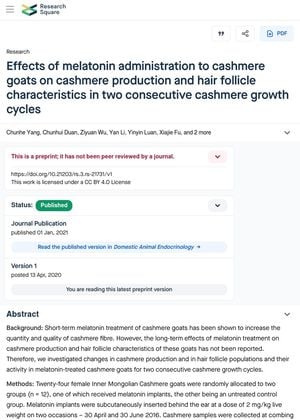Effects of Melatonin Administration to Cashmere Goats on Cashmere Production and Hair Follicle Characteristics in Two Consecutive Cashmere Growth Cycles
April 2020
in “
Research Square (Research Square)
”

TLDR Melatonin treatment improved cashmere production in goats for one cycle without lasting effects on the next cycle.
Three years ago, a study was conducted on 24 female Inner Mongolian Cashmere goats to investigate the long-term effects of melatonin treatment on cashmere production and hair follicle characteristics. The goats were divided into two groups, one receiving melatonin implants and the other serving as a control. The study found that melatonin treatment in one cashmere growth cycle increased the weight, length, and density of cashmere fibre, and decreased its diameter. However, these effects did not carry over to the next annual cycle. The treatment also advanced the onset of activity of secondary hair follicles by 2 months and increased the population of active follicles in the first growth cycle, but had no effect on the follicle population in the consecutive cycles. Serum melatonin concentrations were elevated in the treated goats during the first growth cycle. The study concluded that melatonin treatment improved cashmere production for one cycle only, with no residual effects on the following cycle, making the technique acceptable to the cashmere goat industry.




